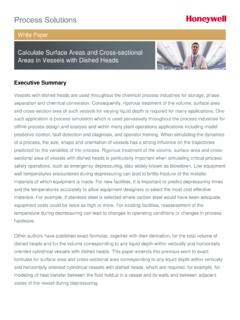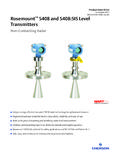Transcription of Applying Tank Farm Safety Standards for Petroleum Storage ...
1 Applying Tank Farm Safety Standards for Petroleum Storage Tanks in India S. K. Ravindran, National Sales Manager, Honeywell Enraf John Joosten, Global Product Manager, Safety & Radar, Honeywell Enraf Applying Tank Farm Safety Standards for Petroleum Storage Tanks in India 2 Table of Contents Introduction .. 3 Overview .. 3 Applicable Standards .. 3 Applying Major Standards .. 4 IEC 61511 & IEC 61508 .. 4 API 2350 .. 4 Buncefield Recommendations .. 5 MB Lal Committee Recommendations .. 6 OISD Guideline 152 .. 6 Tank Gauging Solutions .. 7 Servo Level Gauge .. 7 Servo Gauge .. 9 Radar Gauge .. 11 Other overfill Protection Solutions .. 15 Specifications .. 16 References .. 17 Table of Figures Figure 1. Like other process industry operations, Petroleum tank farms present difficult challenges for automation and Safety technology.. 3 Figure 2. Servo level gauge.. 8 Figure 3. Tank-side indicator.. 8 Figure 4: Typical servo level gauge installation.
2 9 Figure 5. Servo gauge on a floating roof tank.. 9 Figure 6. Servo gauge auto test.. 11 Figure 7. Radar level gauge.. 11 Figure 8. Installation of tank-side 12 Figure 9. overfill protection using radar gauges.. 13 Figure 10. Safety implementation Petroleum Storage facility.. 14 Figure 11. overfill protection subsystem.. 14 Figure 12. Tank overfill system application of recommendations and Standards .. 15 Figure 13. overfill protection switch (ultrasonic pulse signal).. 15 Figure 14. overfill protection switch principle of operation.. 16 Applying Tank Farm Safety Standards for Petroleum Storage Tanks in India 3 Introduction Like other process industry operations, Petroleum tank farms present difficult challenges for automation and Safety technology. Tank farms, Storage areas and loading/unloading sites all need effective Safety solutions to protect personnel, assets and the environment. The consequences of incidents at these facilities can be enormous.
3 Figure 1. Like other process industry operations, Petroleum tank farms present difficult challenges for automation and Safety technology. The tank farm environment, being a hazardous area, requires continual monitoring of critical process parameters. Accurate and reliable tank level monitoring is especially important to prevent overfill situations. Some overfills are small and easily contained, but the accumulation of product from repeated overfills or a single large spill can cause significant soil and ground water contamination. Worse yet, recent catastrophic incidents at tank farms and terminals can be traced to ineffective Safety technology leading to loss of level control and, ultimately, to loss of containment. Tank farm operations benefit from a holistic approach to industrial Safety , which integrates advanced technology at all plant protection layers - and the people who interact with that technology - to help end-users achieve their Safety objectives.
4 Overview This white paper describes various Standards and recommendations as per international and Indian publications addressing Safety in Petroleum Storage tank farms. It also discusses possible technologies/solutions, which can be used to comply with industry guidelines and create a safe work environment. Applicable Standards IEC 61511, Part 1, 2 & 3 IEC 61508 API 2350 Applying Tank Farm Safety Standards for Petroleum Storage Tanks in India 4 Fire Protection and Prevention Act (NFPA) Oil Industry Safety Directorate (Government of India) Guidelines Buncefield Recommendations MB Lal Committee Recommendations Applying Major Standards Indian tank farm owners/operators adhere to the following Standards and recommendations when implementing systems for tank overfill protection: IEC 61511 & IEC 61508 IEC 61511 defines the Safety standard end-users, Safety instrumented system (SIS) designers and system integrators follow when implementing certified Safety equipment.
5 IEC 61511 applies when equipment meets the requirements of IEC 61508 or if Section of IEC 615111 (prior-use or proven-in-use) is integrated into an overall system used for process sector applications. IEC 61511 clearly states that manufacturers of equipment used on SIS must follow the requirements of IEC 61508 Section 2 and 3 unless the end-user has met the requirements of Section Prior-Use. As such, equipment certified for Safety loops with adequate SIL is a solution. A reasonable level of SIS must be used based on the studies. TUV-c ertified SIL2 instrumentation ( , radar or servo gauges) on tanks adequately meets these requirements. API 2350 API 2350 Clause (a-e), Integrated and Independent Level Detectors, stipulates that high-level detectors and high-high-level detectors must be independent. The use of an auto tank gauging system for high-level detection is allowed. Applying this clause: The radar gauge portion of the tank inventory system combining high-level switching meets the independently certified ( , TUV) requirements for SIL2.
6 In addition, servo level gauges for high-high-level switching ( , overfill Safety switch) meet the independently certified ( , TUV) requirements for SIL2. API 2350 Clause (f) indicates that independent level detectors can be servo level gauges, radar level gauges, or a hydrostatic level gauging system. Applying this clause Radar gauges and servo gauges are both available as the most reliable solutions. API 2350 Section , and , Test Provision for Detectors, stipulates that testing procedures be as simple and replicate an actual alarm condition as realistically as possible. It states that an overfill protection system should be checked upon initial installation, and then retested frequently enough to determine its reliability and develop data establishing the testing, maintenance and inspection schedules. System electronic integrity operational tests should be done 24-hours prior to pipeline transfers, or weekly if pipeline receipts are very frequent.
7 Applying Tank Farm Safety Standards for Petroleum Storage Tanks in India 5 Applying this clause: Switches such as capacitance/vibrating forks or even radar gauges cannot simulate alarm conditions realistically, since they either need to be removed from installation and tested by touching the probe tips, or by giving commands for only the relay operation (radar gauges) checking. Hence, electronic integrity, together with operational mechanism proof testing, is not achieved and requires more labor-intensive methods. Servo gauges should employ operation-checking mechanisms, as per the API recommendations. As a continuous measurement device, these gauges require testing on a frequent basis. This provides an advantage over switches designed to operate when the alarm condition is reached. Servo gauge operation checking is simple and can be performed from tank-side indicators, or even from the control room. The displacer is physically raised till the alarm levels and the operation of output ( , analog output to ESD systems) and relay contact changeover to the Safety PLC can be checked.
8 The entire testing operation takes approximately 10 minutes to complete. API 2350 Section , overfill Protection System Installation, stipulates that when two-stage detector systems are used ( , high-high overfill detector and high-level detection), they should be designed such that failure of any component in the first stage ( , high level) does not interfere with or incapacitate the operation of the second stage ( , high-high detection). Applying this clause: Clearly, the selection of two different types of equipment such as radar for high-level detection and an independent high-high detector ( , servo gauge) meets this requirement. Buncefield Recommendations Competent authorities/operators at Buncefield-type sites should develop and agree upon a common methodology to determine SIL requirements for overfill prevention systems in accordance with the principles set forth in Part 3 of BS EN 61511. Applying this recommendation: The Buncefield Recommendations call for a single, consistent methodology for terminal Safety analysis.
9 The IEC 61511 standard provides such a common methodology for functional Safety , including analysis and determination of the SIL. The use of one common approach for terminal Safety analysis allows for a more transparent overview of the various applications and Safety requirements resulting in a widely accepted and adopted method. This approach is also more cost-effective to maintain and easier to audit by authorities. Operators of Buncefield-type sites can protect against loss of containment of petrol and other highly flammable liquids by adopting a high-integrity, automatic overfill prevention system (or a number of such systems, as appropriate) physically and electrically separate and independent from the tank gauging system. Applying this recommendation: For adequate overfill detection, users should select a device developed by a certified hardware and software designer that is independent from the level gauge used as a primary level indicator, and employing a different method of level measurement .
10 The process industries have a long and successful practice of Applying redundant process control and Safety systems to operate their critical processes. Redundant process control systems and Safety systems have achieved superior reliability and high availability through the application of a very important architectural first principle known as the Applying Tank Farm Safety Standards for Petroleum Storage Tanks in India 6 separation principle. The design criterion behind this principle is simple: separate Safety and control. A radar- or servo gauge-based continuous level monitoring system, and a servo gauge-based independent overfill device with continuous monitoring and proof testing mechanisms, fulfills this requirement. All elements of an overfill prevention system should be proof tested in accordance with validated arrangements and procedures, and on a sufficiently frequent basis, to ensure the specified Safety integrity level is maintained, in practice, in accordance with the requirements of Part 1 of BS EN 61511.











